PPMP20009: Leading Lean Projects Report - Dream Home Project
VerifiedAdded on 2022/10/19
|10
|3118
|226
Report
AI Summary
This report details the application of lean project management principles to the construction of a dream home in Perth, Australia. It begins by outlining the process of choosing a suburb (Golden Bay), land size, and a builder (Mindful Boutique Builders & Renovators), with an emphasis on the PMBOK methodology for project management. The report then explores factors influencing design and layout, alongside the project management processes, including safety, financial, and claim management. Finally, it delves into the implementation of best lean practices, such as simple processes, stakeholder identification, project charter development, portfolio and resource management, and addressing organizational constraints, with the ultimate goal of delivering customer value efficiently and minimizing resource wastage. The project also considers future expansions, material handling, and inventory management within the construction process. This report provides a comprehensive overview of how lean principles can be effectively utilized in a real-world construction project.
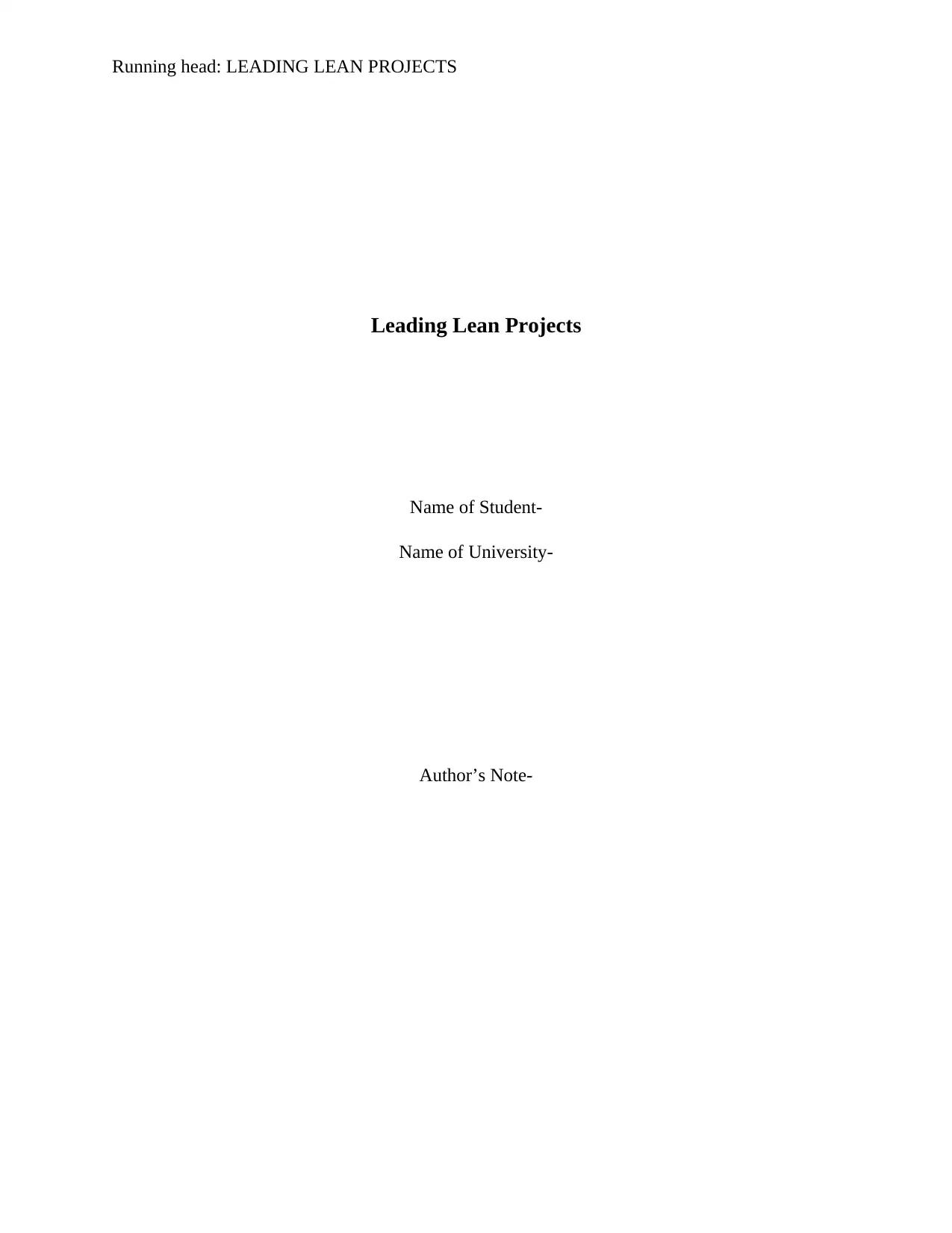
Running head: LEADING LEAN PROJECTS
Leading Lean Projects
Name of Student-
Name of University-
Author’s Note-
Leading Lean Projects
Name of Student-
Name of University-
Author’s Note-
Paraphrase This Document
Need a fresh take? Get an instant paraphrase of this document with our AI Paraphraser
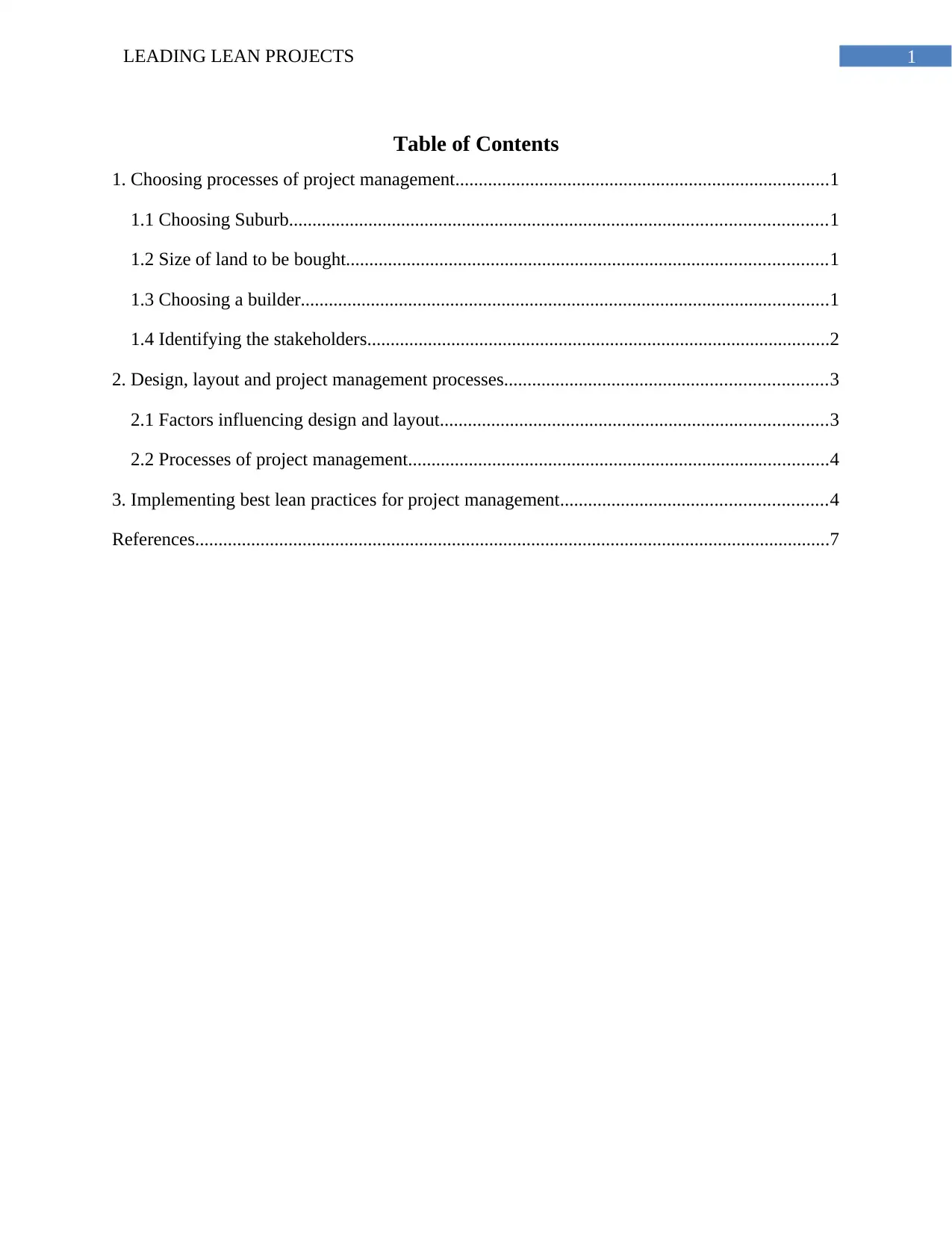
1LEADING LEAN PROJECTS
Table of Contents
1. Choosing processes of project management................................................................................1
1.1 Choosing Suburb...................................................................................................................1
1.2 Size of land to be bought.......................................................................................................1
1.3 Choosing a builder.................................................................................................................1
1.4 Identifying the stakeholders...................................................................................................2
2. Design, layout and project management processes.....................................................................3
2.1 Factors influencing design and layout...................................................................................3
2.2 Processes of project management..........................................................................................4
3. Implementing best lean practices for project management.........................................................4
References........................................................................................................................................7
Table of Contents
1. Choosing processes of project management................................................................................1
1.1 Choosing Suburb...................................................................................................................1
1.2 Size of land to be bought.......................................................................................................1
1.3 Choosing a builder.................................................................................................................1
1.4 Identifying the stakeholders...................................................................................................2
2. Design, layout and project management processes.....................................................................3
2.1 Factors influencing design and layout...................................................................................3
2.2 Processes of project management..........................................................................................4
3. Implementing best lean practices for project management.........................................................4
References........................................................................................................................................7
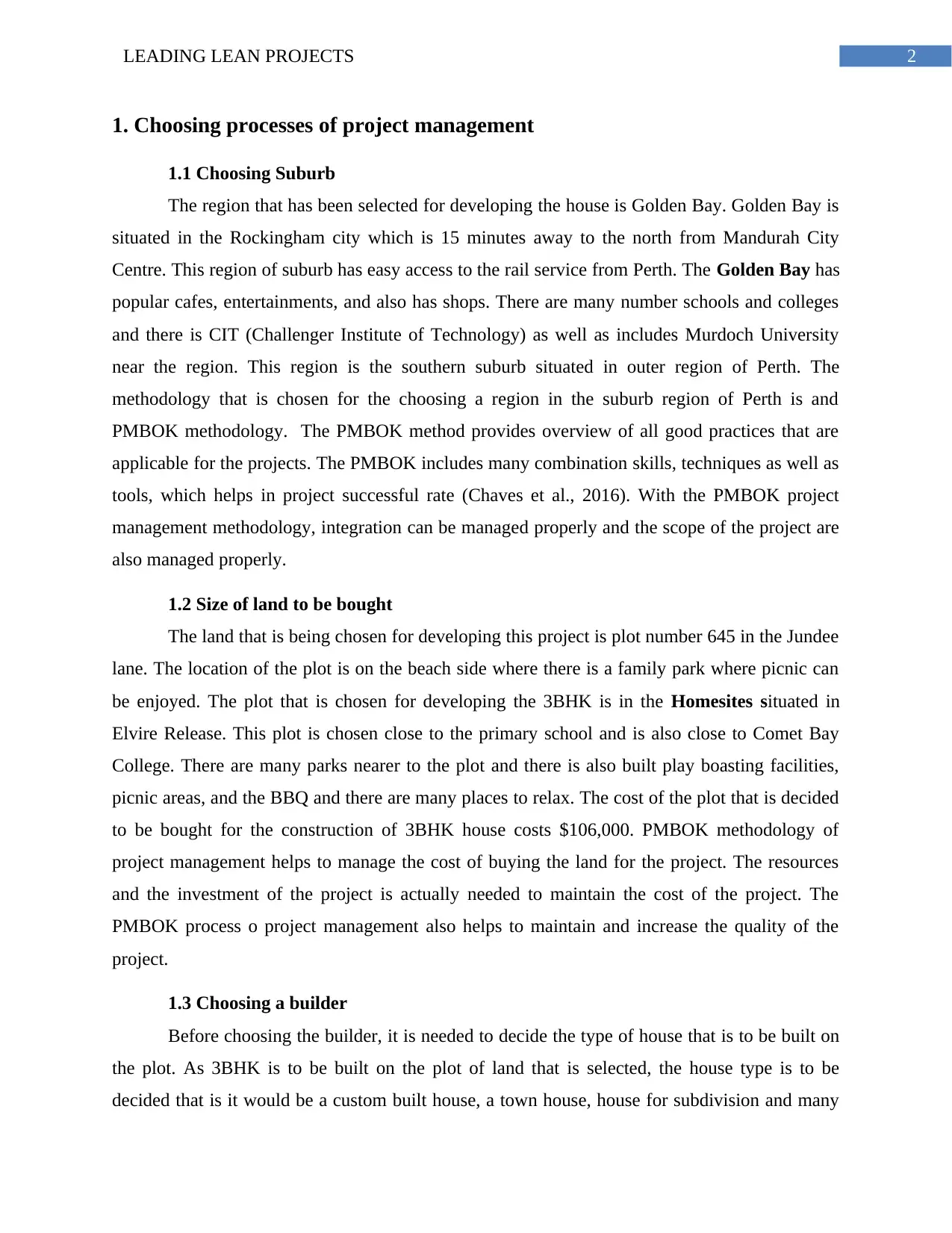
2LEADING LEAN PROJECTS
1. Choosing processes of project management
1.1 Choosing Suburb
The region that has been selected for developing the house is Golden Bay. Golden Bay is
situated in the Rockingham city which is 15 minutes away to the north from Mandurah City
Centre. This region of suburb has easy access to the rail service from Perth. The Golden Bay has
popular cafes, entertainments, and also has shops. There are many number schools and colleges
and there is CIT (Challenger Institute of Technology) as well as includes Murdoch University
near the region. This region is the southern suburb situated in outer region of Perth. The
methodology that is chosen for the choosing a region in the suburb region of Perth is and
PMBOK methodology. The PMBOK method provides overview of all good practices that are
applicable for the projects. The PMBOK includes many combination skills, techniques as well as
tools, which helps in project successful rate (Chaves et al., 2016). With the PMBOK project
management methodology, integration can be managed properly and the scope of the project are
also managed properly.
1.2 Size of land to be bought
The land that is being chosen for developing this project is plot number 645 in the Jundee
lane. The location of the plot is on the beach side where there is a family park where picnic can
be enjoyed. The plot that is chosen for developing the 3BHK is in the Homesites situated in
Elvire Release. This plot is chosen close to the primary school and is also close to Comet Bay
College. There are many parks nearer to the plot and there is also built play boasting facilities,
picnic areas, and the BBQ and there are many places to relax. The cost of the plot that is decided
to be bought for the construction of 3BHK house costs $106,000. PMBOK methodology of
project management helps to manage the cost of buying the land for the project. The resources
and the investment of the project is actually needed to maintain the cost of the project. The
PMBOK process o project management also helps to maintain and increase the quality of the
project.
1.3 Choosing a builder
Before choosing the builder, it is needed to decide the type of house that is to be built on
the plot. As 3BHK is to be built on the plot of land that is selected, the house type is to be
decided that is it would be a custom built house, a town house, house for subdivision and many
1. Choosing processes of project management
1.1 Choosing Suburb
The region that has been selected for developing the house is Golden Bay. Golden Bay is
situated in the Rockingham city which is 15 minutes away to the north from Mandurah City
Centre. This region of suburb has easy access to the rail service from Perth. The Golden Bay has
popular cafes, entertainments, and also has shops. There are many number schools and colleges
and there is CIT (Challenger Institute of Technology) as well as includes Murdoch University
near the region. This region is the southern suburb situated in outer region of Perth. The
methodology that is chosen for the choosing a region in the suburb region of Perth is and
PMBOK methodology. The PMBOK method provides overview of all good practices that are
applicable for the projects. The PMBOK includes many combination skills, techniques as well as
tools, which helps in project successful rate (Chaves et al., 2016). With the PMBOK project
management methodology, integration can be managed properly and the scope of the project are
also managed properly.
1.2 Size of land to be bought
The land that is being chosen for developing this project is plot number 645 in the Jundee
lane. The location of the plot is on the beach side where there is a family park where picnic can
be enjoyed. The plot that is chosen for developing the 3BHK is in the Homesites situated in
Elvire Release. This plot is chosen close to the primary school and is also close to Comet Bay
College. There are many parks nearer to the plot and there is also built play boasting facilities,
picnic areas, and the BBQ and there are many places to relax. The cost of the plot that is decided
to be bought for the construction of 3BHK house costs $106,000. PMBOK methodology of
project management helps to manage the cost of buying the land for the project. The resources
and the investment of the project is actually needed to maintain the cost of the project. The
PMBOK process o project management also helps to maintain and increase the quality of the
project.
1.3 Choosing a builder
Before choosing the builder, it is needed to decide the type of house that is to be built on
the plot. As 3BHK is to be built on the plot of land that is selected, the house type is to be
decided that is it would be a custom built house, a town house, house for subdivision and many
⊘ This is a preview!⊘
Do you want full access?
Subscribe today to unlock all pages.

Trusted by 1+ million students worldwide
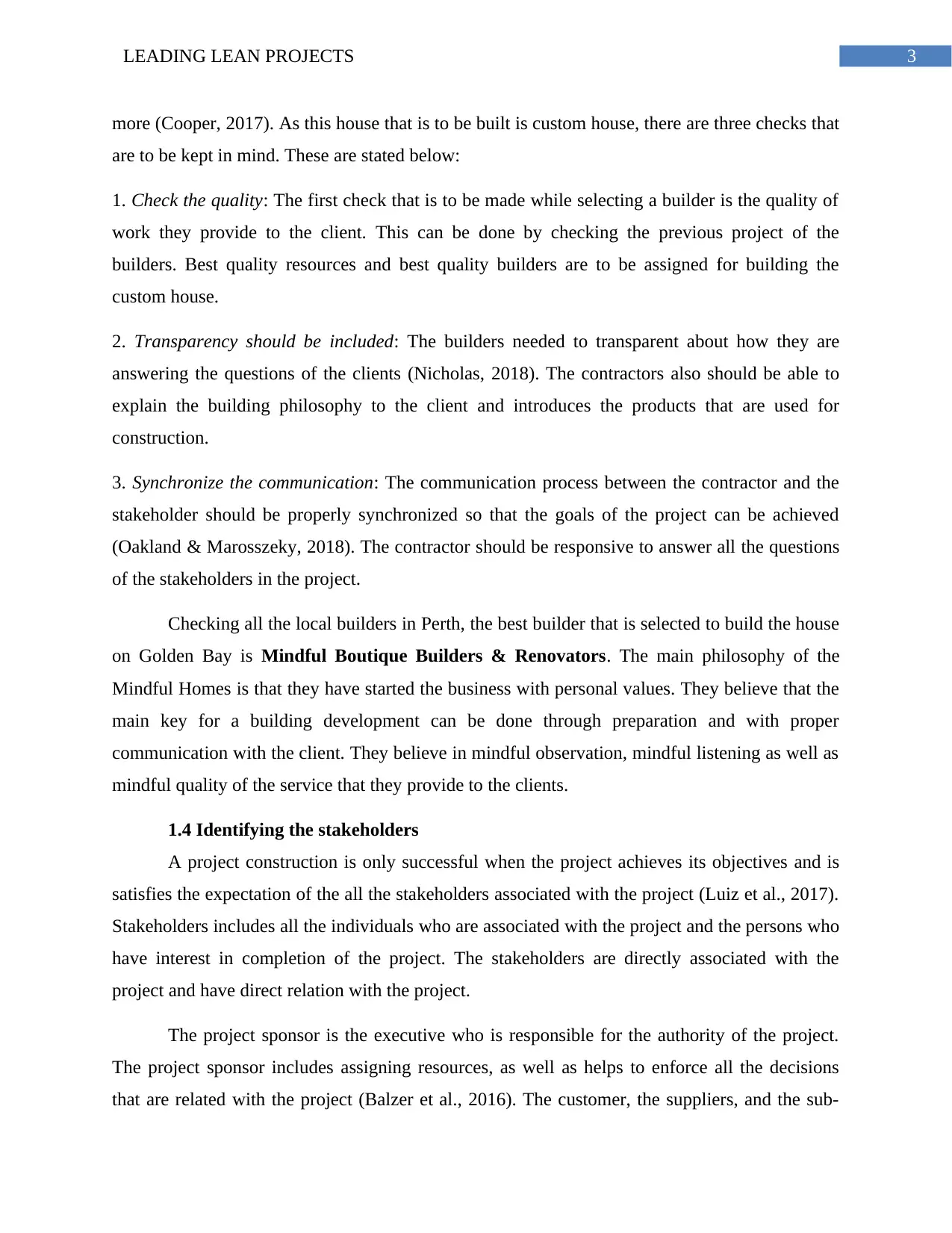
3LEADING LEAN PROJECTS
more (Cooper, 2017). As this house that is to be built is custom house, there are three checks that
are to be kept in mind. These are stated below:
1. Check the quality: The first check that is to be made while selecting a builder is the quality of
work they provide to the client. This can be done by checking the previous project of the
builders. Best quality resources and best quality builders are to be assigned for building the
custom house.
2. Transparency should be included: The builders needed to transparent about how they are
answering the questions of the clients (Nicholas, 2018). The contractors also should be able to
explain the building philosophy to the client and introduces the products that are used for
construction.
3. Synchronize the communication: The communication process between the contractor and the
stakeholder should be properly synchronized so that the goals of the project can be achieved
(Oakland & Marosszeky, 2018). The contractor should be responsive to answer all the questions
of the stakeholders in the project.
Checking all the local builders in Perth, the best builder that is selected to build the house
on Golden Bay is Mindful Boutique Builders & Renovators. The main philosophy of the
Mindful Homes is that they have started the business with personal values. They believe that the
main key for a building development can be done through preparation and with proper
communication with the client. They believe in mindful observation, mindful listening as well as
mindful quality of the service that they provide to the clients.
1.4 Identifying the stakeholders
A project construction is only successful when the project achieves its objectives and is
satisfies the expectation of the all the stakeholders associated with the project (Luiz et al., 2017).
Stakeholders includes all the individuals who are associated with the project and the persons who
have interest in completion of the project. The stakeholders are directly associated with the
project and have direct relation with the project.
The project sponsor is the executive who is responsible for the authority of the project.
The project sponsor includes assigning resources, as well as helps to enforce all the decisions
that are related with the project (Balzer et al., 2016). The customer, the suppliers, and the sub-
more (Cooper, 2017). As this house that is to be built is custom house, there are three checks that
are to be kept in mind. These are stated below:
1. Check the quality: The first check that is to be made while selecting a builder is the quality of
work they provide to the client. This can be done by checking the previous project of the
builders. Best quality resources and best quality builders are to be assigned for building the
custom house.
2. Transparency should be included: The builders needed to transparent about how they are
answering the questions of the clients (Nicholas, 2018). The contractors also should be able to
explain the building philosophy to the client and introduces the products that are used for
construction.
3. Synchronize the communication: The communication process between the contractor and the
stakeholder should be properly synchronized so that the goals of the project can be achieved
(Oakland & Marosszeky, 2018). The contractor should be responsive to answer all the questions
of the stakeholders in the project.
Checking all the local builders in Perth, the best builder that is selected to build the house
on Golden Bay is Mindful Boutique Builders & Renovators. The main philosophy of the
Mindful Homes is that they have started the business with personal values. They believe that the
main key for a building development can be done through preparation and with proper
communication with the client. They believe in mindful observation, mindful listening as well as
mindful quality of the service that they provide to the clients.
1.4 Identifying the stakeholders
A project construction is only successful when the project achieves its objectives and is
satisfies the expectation of the all the stakeholders associated with the project (Luiz et al., 2017).
Stakeholders includes all the individuals who are associated with the project and the persons who
have interest in completion of the project. The stakeholders are directly associated with the
project and have direct relation with the project.
The project sponsor is the executive who is responsible for the authority of the project.
The project sponsor includes assigning resources, as well as helps to enforce all the decisions
that are related with the project (Balzer et al., 2016). The customer, the suppliers, and the sub-
Paraphrase This Document
Need a fresh take? Get an instant paraphrase of this document with our AI Paraphraser
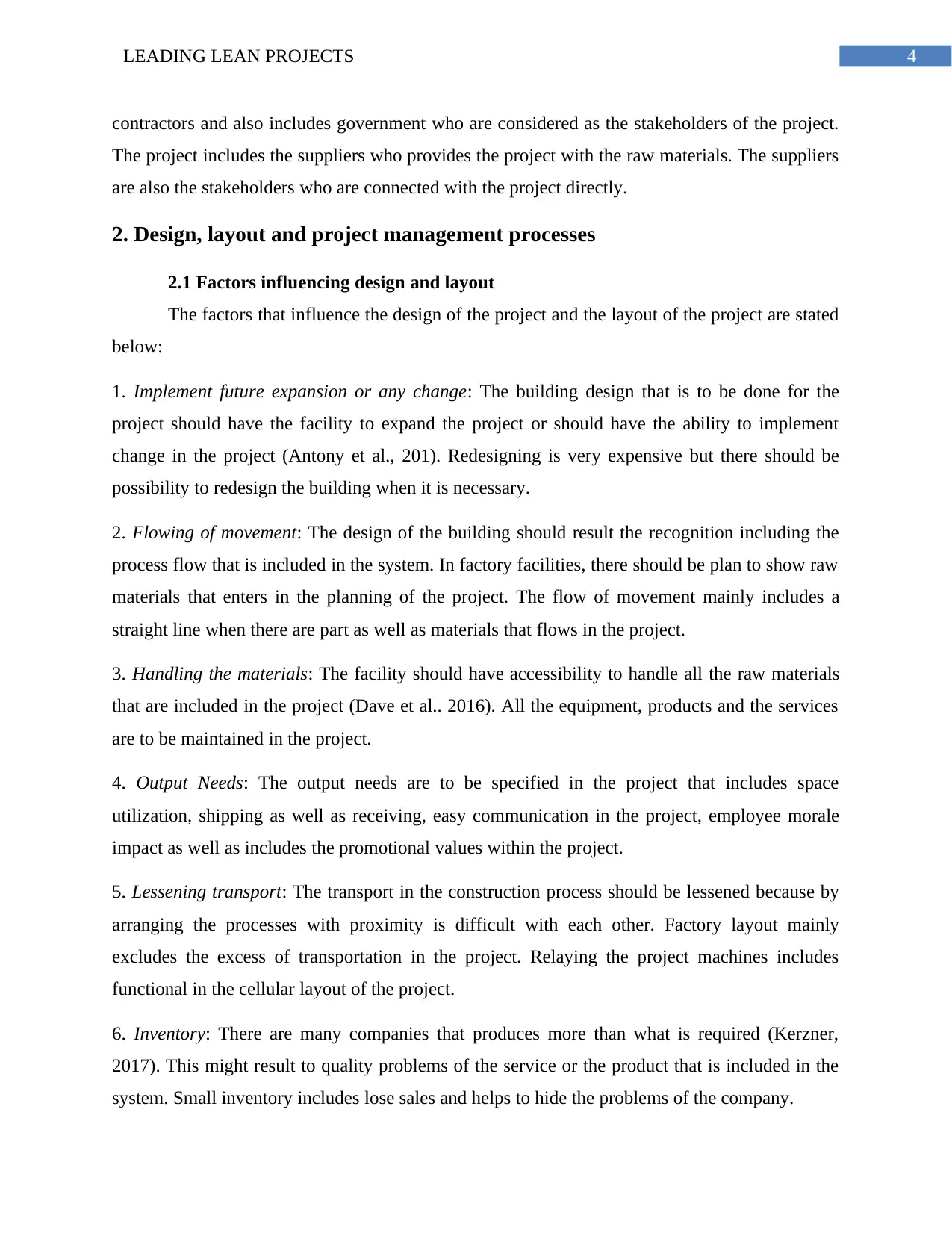
4LEADING LEAN PROJECTS
contractors and also includes government who are considered as the stakeholders of the project.
The project includes the suppliers who provides the project with the raw materials. The suppliers
are also the stakeholders who are connected with the project directly.
2. Design, layout and project management processes
2.1 Factors influencing design and layout
The factors that influence the design of the project and the layout of the project are stated
below:
1. Implement future expansion or any change: The building design that is to be done for the
project should have the facility to expand the project or should have the ability to implement
change in the project (Antony et al., 201). Redesigning is very expensive but there should be
possibility to redesign the building when it is necessary.
2. Flowing of movement: The design of the building should result the recognition including the
process flow that is included in the system. In factory facilities, there should be plan to show raw
materials that enters in the planning of the project. The flow of movement mainly includes a
straight line when there are part as well as materials that flows in the project.
3. Handling the materials: The facility should have accessibility to handle all the raw materials
that are included in the project (Dave et al.. 2016). All the equipment, products and the services
are to be maintained in the project.
4. Output Needs: The output needs are to be specified in the project that includes space
utilization, shipping as well as receiving, easy communication in the project, employee morale
impact as well as includes the promotional values within the project.
5. Lessening transport: The transport in the construction process should be lessened because by
arranging the processes with proximity is difficult with each other. Factory layout mainly
excludes the excess of transportation in the project. Relaying the project machines includes
functional in the cellular layout of the project.
6. Inventory: There are many companies that produces more than what is required (Kerzner,
2017). This might result to quality problems of the service or the product that is included in the
system. Small inventory includes lose sales and helps to hide the problems of the company.
contractors and also includes government who are considered as the stakeholders of the project.
The project includes the suppliers who provides the project with the raw materials. The suppliers
are also the stakeholders who are connected with the project directly.
2. Design, layout and project management processes
2.1 Factors influencing design and layout
The factors that influence the design of the project and the layout of the project are stated
below:
1. Implement future expansion or any change: The building design that is to be done for the
project should have the facility to expand the project or should have the ability to implement
change in the project (Antony et al., 201). Redesigning is very expensive but there should be
possibility to redesign the building when it is necessary.
2. Flowing of movement: The design of the building should result the recognition including the
process flow that is included in the system. In factory facilities, there should be plan to show raw
materials that enters in the planning of the project. The flow of movement mainly includes a
straight line when there are part as well as materials that flows in the project.
3. Handling the materials: The facility should have accessibility to handle all the raw materials
that are included in the project (Dave et al.. 2016). All the equipment, products and the services
are to be maintained in the project.
4. Output Needs: The output needs are to be specified in the project that includes space
utilization, shipping as well as receiving, easy communication in the project, employee morale
impact as well as includes the promotional values within the project.
5. Lessening transport: The transport in the construction process should be lessened because by
arranging the processes with proximity is difficult with each other. Factory layout mainly
excludes the excess of transportation in the project. Relaying the project machines includes
functional in the cellular layout of the project.
6. Inventory: There are many companies that produces more than what is required (Kerzner,
2017). This might result to quality problems of the service or the product that is included in the
system. Small inventory includes lose sales and helps to hide the problems of the company.
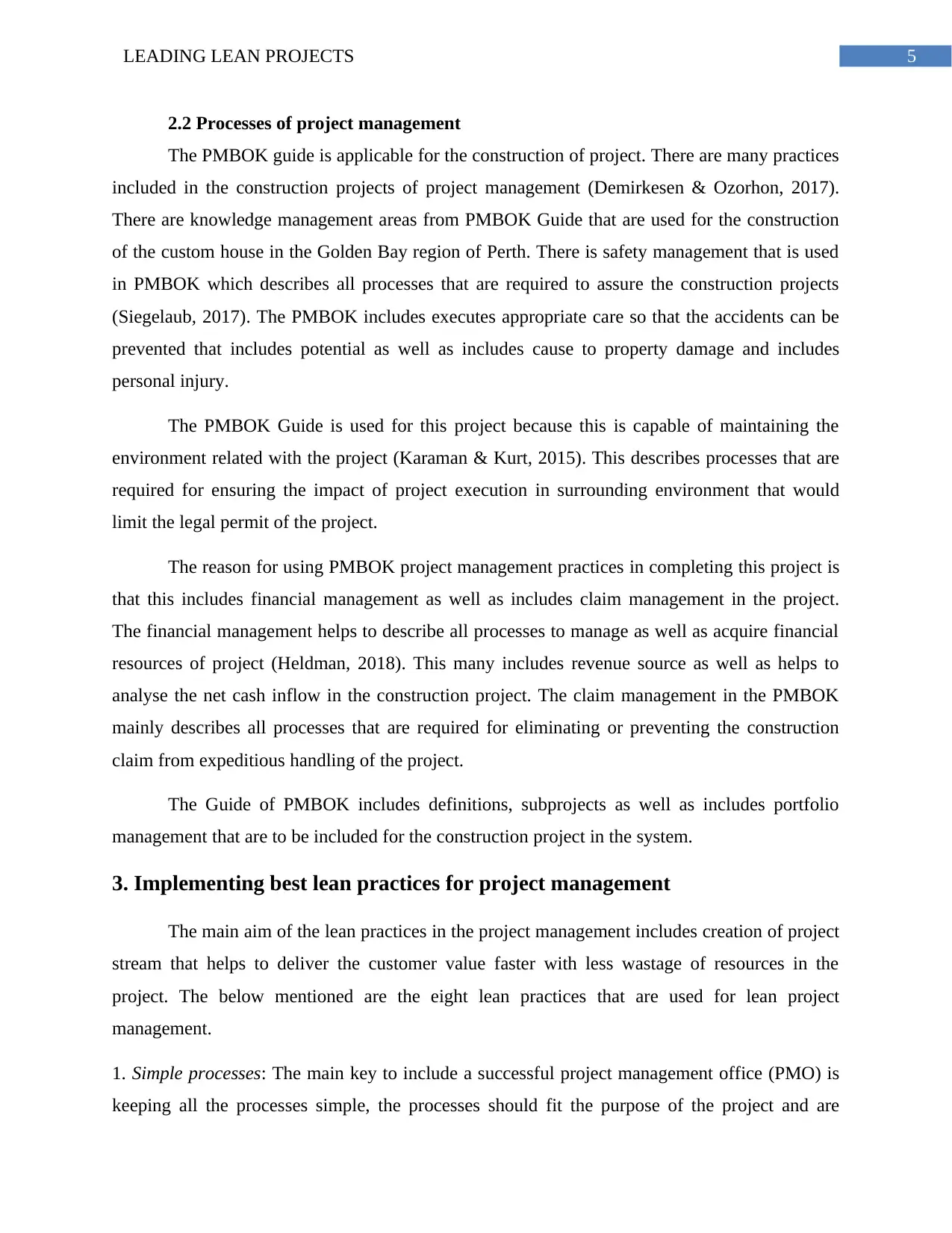
5LEADING LEAN PROJECTS
2.2 Processes of project management
The PMBOK guide is applicable for the construction of project. There are many practices
included in the construction projects of project management (Demirkesen & Ozorhon, 2017).
There are knowledge management areas from PMBOK Guide that are used for the construction
of the custom house in the Golden Bay region of Perth. There is safety management that is used
in PMBOK which describes all processes that are required to assure the construction projects
(Siegelaub, 2017). The PMBOK includes executes appropriate care so that the accidents can be
prevented that includes potential as well as includes cause to property damage and includes
personal injury.
The PMBOK Guide is used for this project because this is capable of maintaining the
environment related with the project (Karaman & Kurt, 2015). This describes processes that are
required for ensuring the impact of project execution in surrounding environment that would
limit the legal permit of the project.
The reason for using PMBOK project management practices in completing this project is
that this includes financial management as well as includes claim management in the project.
The financial management helps to describe all processes to manage as well as acquire financial
resources of project (Heldman, 2018). This many includes revenue source as well as helps to
analyse the net cash inflow in the construction project. The claim management in the PMBOK
mainly describes all processes that are required for eliminating or preventing the construction
claim from expeditious handling of the project.
The Guide of PMBOK includes definitions, subprojects as well as includes portfolio
management that are to be included for the construction project in the system.
3. Implementing best lean practices for project management
The main aim of the lean practices in the project management includes creation of project
stream that helps to deliver the customer value faster with less wastage of resources in the
project. The below mentioned are the eight lean practices that are used for lean project
management.
1. Simple processes: The main key to include a successful project management office (PMO) is
keeping all the processes simple, the processes should fit the purpose of the project and are
2.2 Processes of project management
The PMBOK guide is applicable for the construction of project. There are many practices
included in the construction projects of project management (Demirkesen & Ozorhon, 2017).
There are knowledge management areas from PMBOK Guide that are used for the construction
of the custom house in the Golden Bay region of Perth. There is safety management that is used
in PMBOK which describes all processes that are required to assure the construction projects
(Siegelaub, 2017). The PMBOK includes executes appropriate care so that the accidents can be
prevented that includes potential as well as includes cause to property damage and includes
personal injury.
The PMBOK Guide is used for this project because this is capable of maintaining the
environment related with the project (Karaman & Kurt, 2015). This describes processes that are
required for ensuring the impact of project execution in surrounding environment that would
limit the legal permit of the project.
The reason for using PMBOK project management practices in completing this project is
that this includes financial management as well as includes claim management in the project.
The financial management helps to describe all processes to manage as well as acquire financial
resources of project (Heldman, 2018). This many includes revenue source as well as helps to
analyse the net cash inflow in the construction project. The claim management in the PMBOK
mainly describes all processes that are required for eliminating or preventing the construction
claim from expeditious handling of the project.
The Guide of PMBOK includes definitions, subprojects as well as includes portfolio
management that are to be included for the construction project in the system.
3. Implementing best lean practices for project management
The main aim of the lean practices in the project management includes creation of project
stream that helps to deliver the customer value faster with less wastage of resources in the
project. The below mentioned are the eight lean practices that are used for lean project
management.
1. Simple processes: The main key to include a successful project management office (PMO) is
keeping all the processes simple, the processes should fit the purpose of the project and are
⊘ This is a preview!⊘
Do you want full access?
Subscribe today to unlock all pages.

Trusted by 1+ million students worldwide
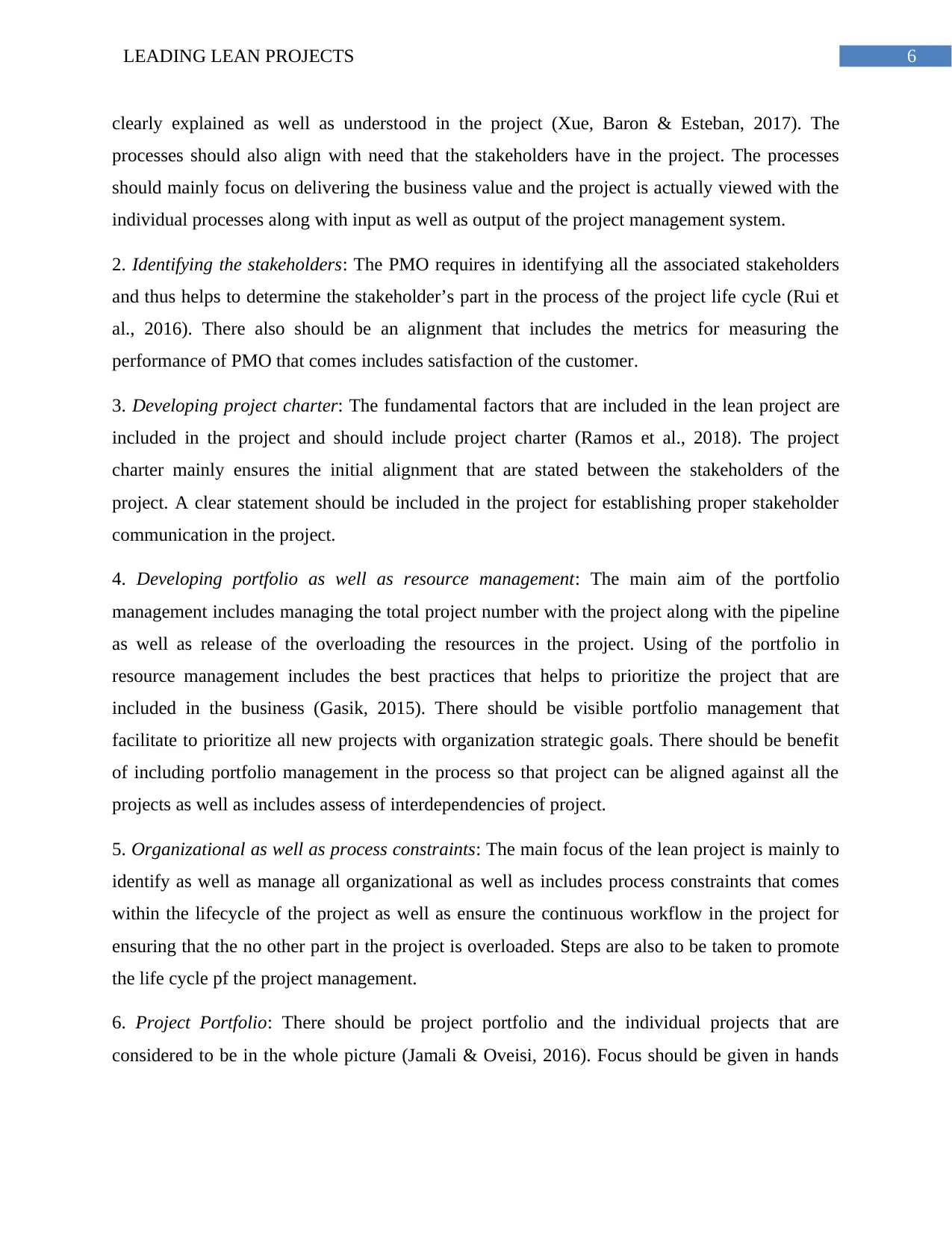
6LEADING LEAN PROJECTS
clearly explained as well as understood in the project (Xue, Baron & Esteban, 2017). The
processes should also align with need that the stakeholders have in the project. The processes
should mainly focus on delivering the business value and the project is actually viewed with the
individual processes along with input as well as output of the project management system.
2. Identifying the stakeholders: The PMO requires in identifying all the associated stakeholders
and thus helps to determine the stakeholder’s part in the process of the project life cycle (Rui et
al., 2016). There also should be an alignment that includes the metrics for measuring the
performance of PMO that comes includes satisfaction of the customer.
3. Developing project charter: The fundamental factors that are included in the lean project are
included in the project and should include project charter (Ramos et al., 2018). The project
charter mainly ensures the initial alignment that are stated between the stakeholders of the
project. A clear statement should be included in the project for establishing proper stakeholder
communication in the project.
4. Developing portfolio as well as resource management: The main aim of the portfolio
management includes managing the total project number with the project along with the pipeline
as well as release of the overloading the resources in the project. Using of the portfolio in
resource management includes the best practices that helps to prioritize the project that are
included in the business (Gasik, 2015). There should be visible portfolio management that
facilitate to prioritize all new projects with organization strategic goals. There should be benefit
of including portfolio management in the process so that project can be aligned against all the
projects as well as includes assess of interdependencies of project.
5. Organizational as well as process constraints: The main focus of the lean project is mainly to
identify as well as manage all organizational as well as includes process constraints that comes
within the lifecycle of the project as well as ensure the continuous workflow in the project for
ensuring that the no other part in the project is overloaded. Steps are also to be taken to promote
the life cycle pf the project management.
6. Project Portfolio: There should be project portfolio and the individual projects that are
considered to be in the whole picture (Jamali & Oveisi, 2016). Focus should be given in hands
clearly explained as well as understood in the project (Xue, Baron & Esteban, 2017). The
processes should also align with need that the stakeholders have in the project. The processes
should mainly focus on delivering the business value and the project is actually viewed with the
individual processes along with input as well as output of the project management system.
2. Identifying the stakeholders: The PMO requires in identifying all the associated stakeholders
and thus helps to determine the stakeholder’s part in the process of the project life cycle (Rui et
al., 2016). There also should be an alignment that includes the metrics for measuring the
performance of PMO that comes includes satisfaction of the customer.
3. Developing project charter: The fundamental factors that are included in the lean project are
included in the project and should include project charter (Ramos et al., 2018). The project
charter mainly ensures the initial alignment that are stated between the stakeholders of the
project. A clear statement should be included in the project for establishing proper stakeholder
communication in the project.
4. Developing portfolio as well as resource management: The main aim of the portfolio
management includes managing the total project number with the project along with the pipeline
as well as release of the overloading the resources in the project. Using of the portfolio in
resource management includes the best practices that helps to prioritize the project that are
included in the business (Gasik, 2015). There should be visible portfolio management that
facilitate to prioritize all new projects with organization strategic goals. There should be benefit
of including portfolio management in the process so that project can be aligned against all the
projects as well as includes assess of interdependencies of project.
5. Organizational as well as process constraints: The main focus of the lean project is mainly to
identify as well as manage all organizational as well as includes process constraints that comes
within the lifecycle of the project as well as ensure the continuous workflow in the project for
ensuring that the no other part in the project is overloaded. Steps are also to be taken to promote
the life cycle pf the project management.
6. Project Portfolio: There should be project portfolio and the individual projects that are
considered to be in the whole picture (Jamali & Oveisi, 2016). Focus should be given in hands
Paraphrase This Document
Need a fresh take? Get an instant paraphrase of this document with our AI Paraphraser
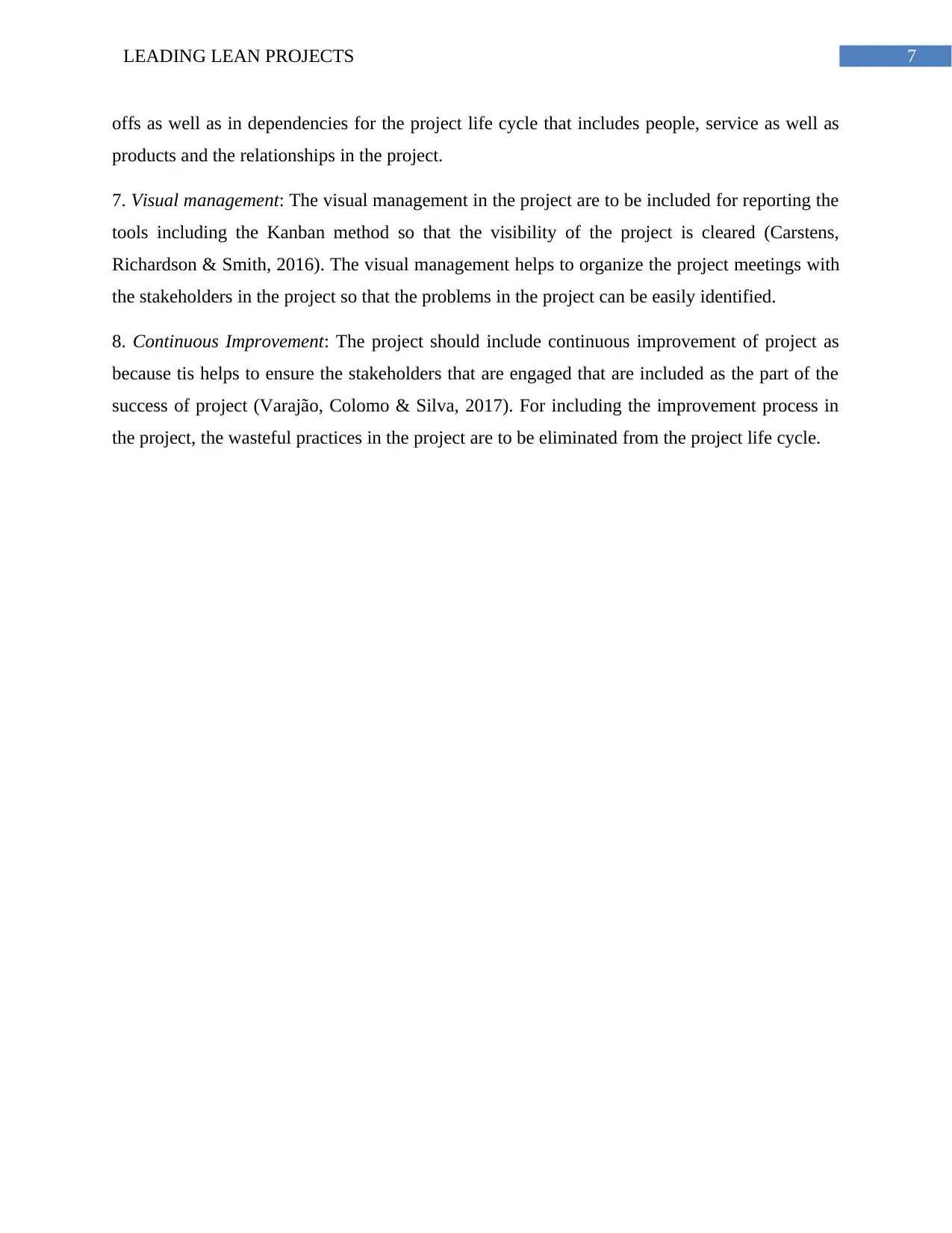
7LEADING LEAN PROJECTS
offs as well as in dependencies for the project life cycle that includes people, service as well as
products and the relationships in the project.
7. Visual management: The visual management in the project are to be included for reporting the
tools including the Kanban method so that the visibility of the project is cleared (Carstens,
Richardson & Smith, 2016). The visual management helps to organize the project meetings with
the stakeholders in the project so that the problems in the project can be easily identified.
8. Continuous Improvement: The project should include continuous improvement of project as
because tis helps to ensure the stakeholders that are engaged that are included as the part of the
success of project (Varajão, Colomo & Silva, 2017). For including the improvement process in
the project, the wasteful practices in the project are to be eliminated from the project life cycle.
offs as well as in dependencies for the project life cycle that includes people, service as well as
products and the relationships in the project.
7. Visual management: The visual management in the project are to be included for reporting the
tools including the Kanban method so that the visibility of the project is cleared (Carstens,
Richardson & Smith, 2016). The visual management helps to organize the project meetings with
the stakeholders in the project so that the problems in the project can be easily identified.
8. Continuous Improvement: The project should include continuous improvement of project as
because tis helps to ensure the stakeholders that are engaged that are included as the part of the
success of project (Varajão, Colomo & Silva, 2017). For including the improvement process in
the project, the wasteful practices in the project are to be eliminated from the project life cycle.
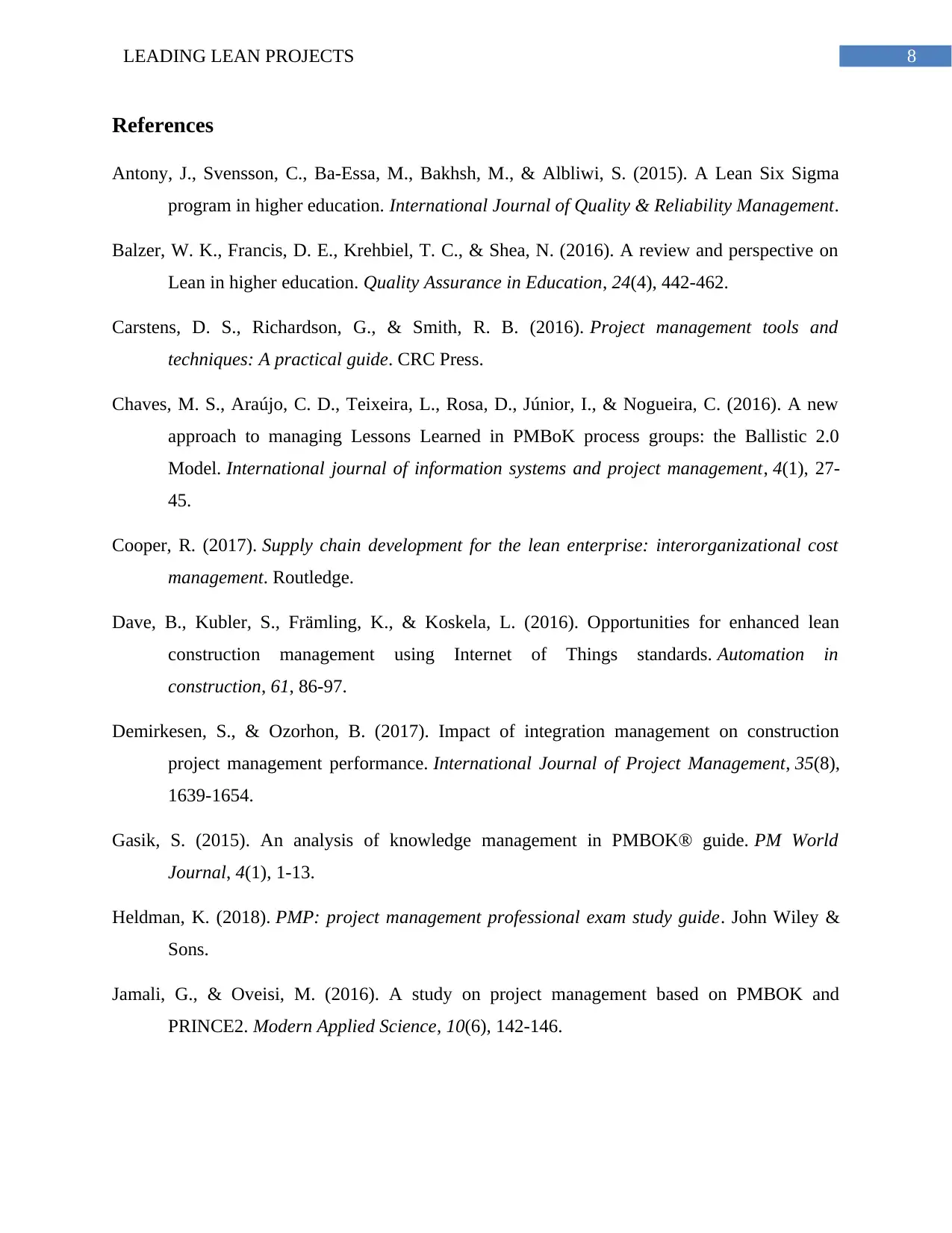
8LEADING LEAN PROJECTS
References
Antony, J., Svensson, C., Ba-Essa, M., Bakhsh, M., & Albliwi, S. (2015). A Lean Six Sigma
program in higher education. International Journal of Quality & Reliability Management.
Balzer, W. K., Francis, D. E., Krehbiel, T. C., & Shea, N. (2016). A review and perspective on
Lean in higher education. Quality Assurance in Education, 24(4), 442-462.
Carstens, D. S., Richardson, G., & Smith, R. B. (2016). Project management tools and
techniques: A practical guide. CRC Press.
Chaves, M. S., Araújo, C. D., Teixeira, L., Rosa, D., Júnior, I., & Nogueira, C. (2016). A new
approach to managing Lessons Learned in PMBoK process groups: the Ballistic 2.0
Model. International journal of information systems and project management, 4(1), 27-
45.
Cooper, R. (2017). Supply chain development for the lean enterprise: interorganizational cost
management. Routledge.
Dave, B., Kubler, S., Främling, K., & Koskela, L. (2016). Opportunities for enhanced lean
construction management using Internet of Things standards. Automation in
construction, 61, 86-97.
Demirkesen, S., & Ozorhon, B. (2017). Impact of integration management on construction
project management performance. International Journal of Project Management, 35(8),
1639-1654.
Gasik, S. (2015). An analysis of knowledge management in PMBOK® guide. PM World
Journal, 4(1), 1-13.
Heldman, K. (2018). PMP: project management professional exam study guide. John Wiley &
Sons.
Jamali, G., & Oveisi, M. (2016). A study on project management based on PMBOK and
PRINCE2. Modern Applied Science, 10(6), 142-146.
References
Antony, J., Svensson, C., Ba-Essa, M., Bakhsh, M., & Albliwi, S. (2015). A Lean Six Sigma
program in higher education. International Journal of Quality & Reliability Management.
Balzer, W. K., Francis, D. E., Krehbiel, T. C., & Shea, N. (2016). A review and perspective on
Lean in higher education. Quality Assurance in Education, 24(4), 442-462.
Carstens, D. S., Richardson, G., & Smith, R. B. (2016). Project management tools and
techniques: A practical guide. CRC Press.
Chaves, M. S., Araújo, C. D., Teixeira, L., Rosa, D., Júnior, I., & Nogueira, C. (2016). A new
approach to managing Lessons Learned in PMBoK process groups: the Ballistic 2.0
Model. International journal of information systems and project management, 4(1), 27-
45.
Cooper, R. (2017). Supply chain development for the lean enterprise: interorganizational cost
management. Routledge.
Dave, B., Kubler, S., Främling, K., & Koskela, L. (2016). Opportunities for enhanced lean
construction management using Internet of Things standards. Automation in
construction, 61, 86-97.
Demirkesen, S., & Ozorhon, B. (2017). Impact of integration management on construction
project management performance. International Journal of Project Management, 35(8),
1639-1654.
Gasik, S. (2015). An analysis of knowledge management in PMBOK® guide. PM World
Journal, 4(1), 1-13.
Heldman, K. (2018). PMP: project management professional exam study guide. John Wiley &
Sons.
Jamali, G., & Oveisi, M. (2016). A study on project management based on PMBOK and
PRINCE2. Modern Applied Science, 10(6), 142-146.
⊘ This is a preview!⊘
Do you want full access?
Subscribe today to unlock all pages.

Trusted by 1+ million students worldwide
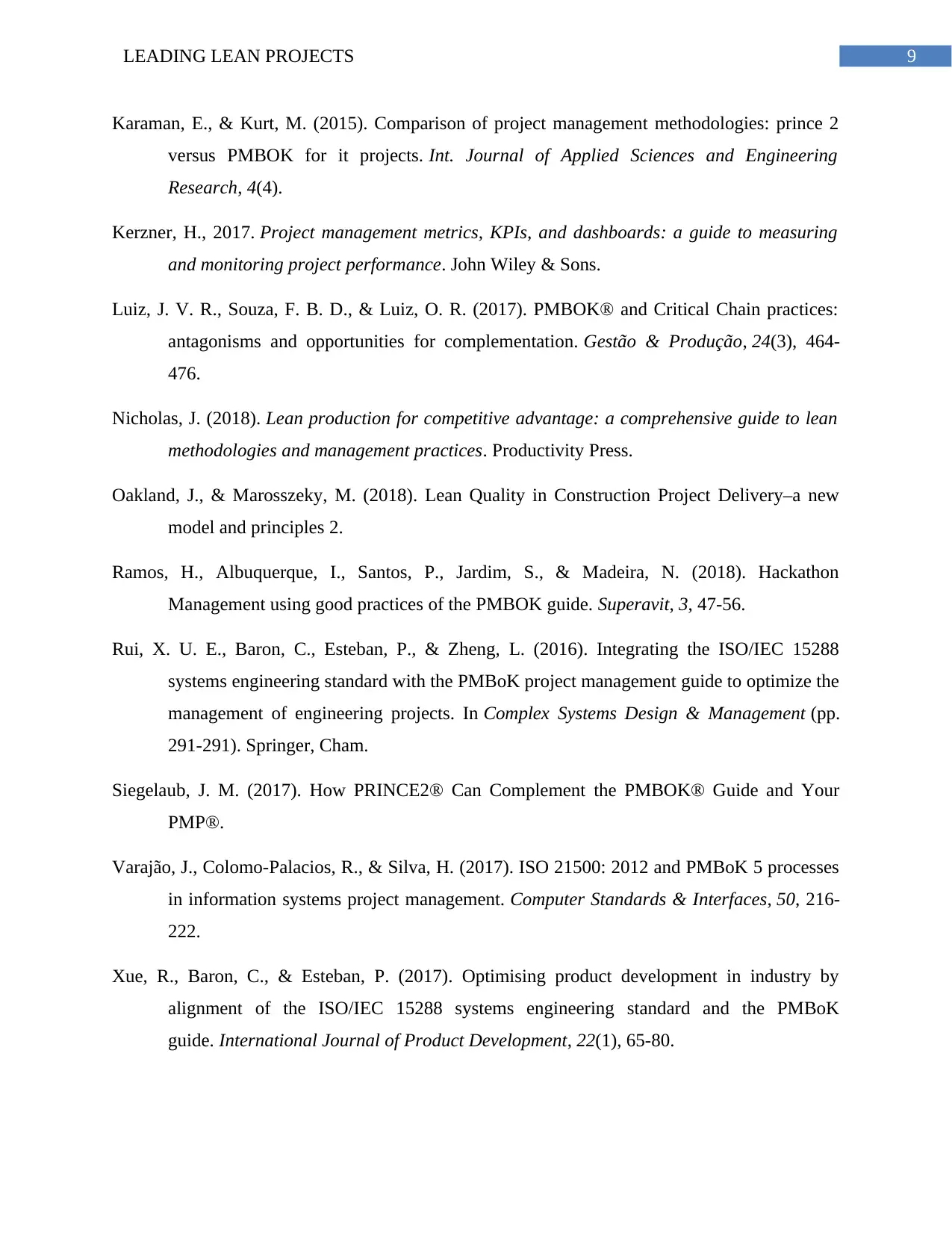
9LEADING LEAN PROJECTS
Karaman, E., & Kurt, M. (2015). Comparison of project management methodologies: prince 2
versus PMBOK for it projects. Int. Journal of Applied Sciences and Engineering
Research, 4(4).
Kerzner, H., 2017. Project management metrics, KPIs, and dashboards: a guide to measuring
and monitoring project performance. John Wiley & Sons.
Luiz, J. V. R., Souza, F. B. D., & Luiz, O. R. (2017). PMBOK® and Critical Chain practices:
antagonisms and opportunities for complementation. Gestão & Produção, 24(3), 464-
476.
Nicholas, J. (2018). Lean production for competitive advantage: a comprehensive guide to lean
methodologies and management practices. Productivity Press.
Oakland, J., & Marosszeky, M. (2018). Lean Quality in Construction Project Delivery–a new
model and principles 2.
Ramos, H., Albuquerque, I., Santos, P., Jardim, S., & Madeira, N. (2018). Hackathon
Management using good practices of the PMBOK guide. Superavit, 3, 47-56.
Rui, X. U. E., Baron, C., Esteban, P., & Zheng, L. (2016). Integrating the ISO/IEC 15288
systems engineering standard with the PMBoK project management guide to optimize the
management of engineering projects. In Complex Systems Design & Management (pp.
291-291). Springer, Cham.
Siegelaub, J. M. (2017). How PRINCE2® Can Complement the PMBOK® Guide and Your
PMP®.
Varajão, J., Colomo-Palacios, R., & Silva, H. (2017). ISO 21500: 2012 and PMBoK 5 processes
in information systems project management. Computer Standards & Interfaces, 50, 216-
222.
Xue, R., Baron, C., & Esteban, P. (2017). Optimising product development in industry by
alignment of the ISO/IEC 15288 systems engineering standard and the PMBoK
guide. International Journal of Product Development, 22(1), 65-80.
Karaman, E., & Kurt, M. (2015). Comparison of project management methodologies: prince 2
versus PMBOK for it projects. Int. Journal of Applied Sciences and Engineering
Research, 4(4).
Kerzner, H., 2017. Project management metrics, KPIs, and dashboards: a guide to measuring
and monitoring project performance. John Wiley & Sons.
Luiz, J. V. R., Souza, F. B. D., & Luiz, O. R. (2017). PMBOK® and Critical Chain practices:
antagonisms and opportunities for complementation. Gestão & Produção, 24(3), 464-
476.
Nicholas, J. (2018). Lean production for competitive advantage: a comprehensive guide to lean
methodologies and management practices. Productivity Press.
Oakland, J., & Marosszeky, M. (2018). Lean Quality in Construction Project Delivery–a new
model and principles 2.
Ramos, H., Albuquerque, I., Santos, P., Jardim, S., & Madeira, N. (2018). Hackathon
Management using good practices of the PMBOK guide. Superavit, 3, 47-56.
Rui, X. U. E., Baron, C., Esteban, P., & Zheng, L. (2016). Integrating the ISO/IEC 15288
systems engineering standard with the PMBoK project management guide to optimize the
management of engineering projects. In Complex Systems Design & Management (pp.
291-291). Springer, Cham.
Siegelaub, J. M. (2017). How PRINCE2® Can Complement the PMBOK® Guide and Your
PMP®.
Varajão, J., Colomo-Palacios, R., & Silva, H. (2017). ISO 21500: 2012 and PMBoK 5 processes
in information systems project management. Computer Standards & Interfaces, 50, 216-
222.
Xue, R., Baron, C., & Esteban, P. (2017). Optimising product development in industry by
alignment of the ISO/IEC 15288 systems engineering standard and the PMBoK
guide. International Journal of Product Development, 22(1), 65-80.
1 out of 10
Related Documents
Your All-in-One AI-Powered Toolkit for Academic Success.
+13062052269
info@desklib.com
Available 24*7 on WhatsApp / Email
![[object Object]](/_next/static/media/star-bottom.7253800d.svg)
Unlock your academic potential
Copyright © 2020–2025 A2Z Services. All Rights Reserved. Developed and managed by ZUCOL.





